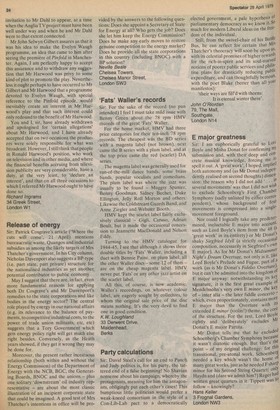E major greatness
Sir: I am euphorically grateful to Lorc Boyle and Misha Donat for confirming my submission and, with their deep and concrete musical knowledge, forcing me to spell it out. A 'great work', I hoped, implied both autonomy and (as Mr Donat indePen" dently realised on second thoughts) dime sion: the reason why I did not add' several • • several movements' was that I did not wisli to exclude Schoenberg's First Chamber Symphony (sadly unlisted by either correspondent), whose background of four movements is compressed into a singlemovement foreground. Nor could I logically take any predeter.. mined, ineluctable E major into account. such as Lord Boyle's item from the 48 (a 'great work' in its entirety) or Mr Donat's shaky Siegfried Idyll (a strictly occasional composition, necessarily in Siegfried's own E major). As for Mr Donat's Midsummer Night's Dream Overture, not only is it, like Lord Boyle's Prelude and Fugue, part of 9 work (as is Mr Donat's Fidelio Overture), but it can't be admitted into the kingdom of E major anyway: notwithstanding its ke) signature, it is the first great example of Mendelssohn's very own E minor, the keY of inter alia the later fiddle concerto which, even proportionately, contains more E major than the Overture with its extended E minor (violin!) theme, the core of the structure. For the rest, Lord Boyle rightly and 'deliberately' excludes Mr Donat's E major Partita. Mr Donat tells me that he excluded Schoenberg's Chamber Symphony because it wasn't diatonic enough. But that's the point of my original challenge: for this transitional, pre-atonal work, Schoenberg needed a key which wasn't the home 0f many great works, just as he needed F sharp minor for his Second String Quartet: onlY Haydn and (dare we admit him?) Reger had written great quartets in it. Tippett was to follow knowingly?
Hans Keller
3 Frognal Gardens,
London NW3






































 Previous page
Previous page